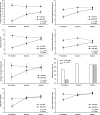Walking Ability is Associated with Social Communication Skills in Infants at High Risk for Autism Spectrum Disorder
- PMID: 30271278
- PMCID: PMC6159946
- DOI: 10.1111/infa.12242
Walking Ability is Associated with Social Communication Skills in Infants at High Risk for Autism Spectrum Disorder
Abstract
Achievement of early motor milestones in infancy affords new opportunities for social interaction and communication. Research has shown that both motor and social deficits are observed in infants who later develop autism spectrum disorder (ASD). The current study examined associations between motor and social-communication skills in 12-month-old infant siblings of children with ASD who are at heightened risk for developmental delays (N=86) and low-risk, typically developing infants (N=113). Infants were classified into one of three groups based on their walking ability: walkers (walks independently), standers (stands independently), or pre-walkers (does not yet stand or walk independently). Social-communication and cognitive skills were assessed with two standardized assessments (Communication and Symbolic Behaviors Scales [CSBS] and Mullen Scales of Early Learning) and compared across the three walking groups. Results demonstrated that high-risk walkers showed superior social-communication skills, but commensurate cognitive skills, compared to high-risk pre-walkers. In contrast, social-communication and cognitive skills were largely comparable for low-risk infants, regardless of walking status. Findings suggest that for high-risk infants, who are already vulnerable to developmental delays and ASD, independent walking may facilitate the emergence of social-communication abilities. Pivotal motor milestones may serve as useful indicators of social-communication delays and targets for intervention.
Keywords: autism spectrum disorder; early identification; motor development; social-communication; walking.
Figures


References
-
- Adolph KE, Berger SE. Handbook of Child Psychology. Hoboken, NJ, USA: John Wiley & Sons, Inc; 2007. Motor Development. - DOI
-
- American Psychiatric Association. Diagnostic and statistical manual of mental disorders: DSM-5. American Psychiatric Association; 2013.
Grants and funding
LinkOut - more resources
Full Text Sources

